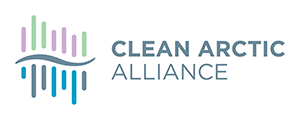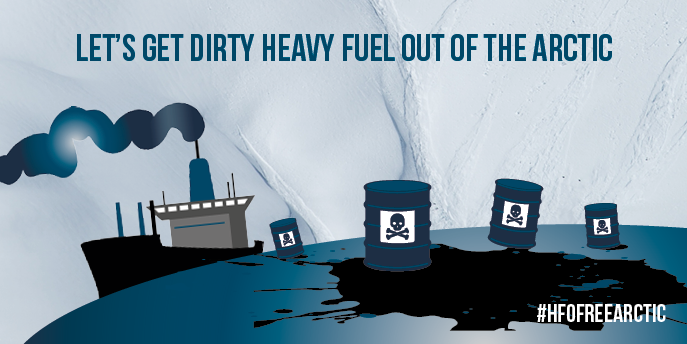Clean Arctic Alliance Response and Clarifications regarding Climatic responses to future trans‐Arctic shipping
London, 4 October 2018:- In a recent article, Climatic responses to future trans‐Arctic shipping, published in the journal Geophysical Research Letters, researchers attempted to quantify the climatic responses to future simulated trans-Arctic shipping from 2006 to 2099 – 81 years into the future — but they’re missing something important. By 2099, Arctic surface temperatures will increase by 10°C compared to 2006 temperatures, according to the highest emissions scenarios used by the researchers. Accounting for the cooling effect of sulfur oxides (SOx) emissions from trans-Arctic shipping, the expected temperature increase falls to 9°C. As the study authors explain, “the shipping-induced cooling (~1°C) is a small fraction of net RCP8.5 warming (~10°C)…”. Therefore, trans-Arctic shipping isn’t reversing the warming trend in the Arctic, the authors admit; rather, it reduces warming by about 10%, according to this study. In a summer that just saw another very low summer sea ice minimum — the sixth-lowest ever, as announced last week by the National Snow and Ice Data Center (NSIDC) — slowing warming is an important goal. But this newly published study does not reflect a realistic future scenario. In fact, it imagines a future where an upcoming fuel sulfur regulation never gets implemented.
In 2008, the International Maritime Organization agreed and then re-confirmed in 2016, that from 2020, fuels used on any ship in the world would be limited to a maximum sulfur content of 0.5%, down from a maximum of 3.5% today.
“This study assumes that all ships transiting the Arctic on Asia-Europe routes are using high sulfur heavy fuel oil with a sulfur content of 2.7% from 2006 to 2099”, explained Scott Stephenson, lead author of the study. “We recognize that the maximum sulfur content of marine fuels globally, including in the Arctic, will be limited to 0.5% starting in 2020, but we did not model this scenario. The real value of this work is that, for the first time, we’ve used a fully coupled earth system model to explore how ship emissions could impact the Arctic”, he said. “As we’ve said, this paper should not be misinterpreted as an endorsement of Arctic shipping as a climate strategy”, Stephenson added.
Ships sailing in Arctic waters predominantly use heavy fuel oil (HFO) or distillate fuels, according to the International Council on Clean Transportation. HFO contains approximately 2.6% sulfur by weight on average, with a maximum sulfur content of 3.5%. Distillate fuels typically contain less than 0.1% sulfur. In 2020, the maximum allowable fuel sulfur content will drop to 0.5%. This means that, beginning in 2020, ships in the Arctic will use 0.5% sulfur-compliant fuels, high sulfur HFO with scrubbers, distillate fuels, or LNG (which contains no sulfur). Making reasonable assumptions about the sulfur content of the fuels that ships will use in the Arctic in 2020 is critical for getting reliable modeling results.
“Fuel sulfur content is the key driver of SOx emissions from ships”” explained Dr Bryan Comer, senior researcher at the International Council on Clean Transportation. “Because this study assumed that all ships use high sulfur heavy fuel oil until 2099, what it really shows is the worst case scenario. It imagines a world where the IMO’s fuel sulfur regulations never happen and where low- and zero-carbon shipping never emerges,” Comer said.
Others agree: “Had the authors accounted for the upcoming regulation – one that the IMO has emphatically said it will not delay – trans-Arctic shipping’s cooling effect, if any, would likely be much smaller”, said Dr Faig Abbasov, Shipping Officer at Transport & Environment.
Burning high sulfur HFO with scrubbers is one way that ships can comply with the IMO’s 2020 global fuel sulfur regulations. However, the IMO is in the process of developing a ban on HFO in the Arctic. The Clean Arctic Alliance anticipates that ships will be prohibited from burning HFO in the Arctic, even with a scrubber, and from carrying it in their fuel tanks. Banning HFO reduces cooling SOx emissions, but it also reduces warming black carbon emissions. Of course, banning HFO also reduces the risk to wildlife from spills and to those communities in the Arctic that depend on marine resources.
“If Arctic shipping is expected to increase in the decades to come, we need appropriate policies in place to protect this pristine environment. In the short-term one of the most important policies will be to ban the use of and carriage for use of HFO by ships in Arctic waters.” said Dr Sian Prior, Lead Advisor to the Clean Arctic Alliance. Added Pam Pearson, Director of the International Cryosphere Climate Initiative, “ff we really wish to slow Arctic warming, a focus on other pollutants — especially, black carbon sources, as advocated recently by Finnish President Niinistö, as part of Finland’s Arctic Council chairmanship — would do far more to slow Arctic warming while benefiting the health of indigenous peoples and others who make the Arctic their home.”
///END///
Additional Notes: Background
- The basic finding of this study, Climatic responses to future trans‐Arctic shipping, published this month in Geophysical Research Letters, that emissions of sulphur oxides (SOx) contribute to global cooling, is not new.
- As well as cooling, emissions of SOx also contribute to significant health problems and to acid rain – a major threat to terrestrial environments.
- Recent decisions to reduce the amount of sulphur emitted in exhaust plumes by international shipping including in the Arctic, have been taken with the knowledge that SOx contributes to cooling but because of the extent of health and environmental impacts associated with SOx emissions there is a need to reduce emissions.
- The complicated interactions between SOx forming light-reflecting particles and black carbon (BC) (also from the combustion of fuel) warming the atmosphere directly and accelerating melt when deposited on snow/ice is a particularly complicated question, and it is difficult to know exactly the amount of SOx it takes to offset BC warming from Arctic shipping.
- Transit shipping through the Arctic routes, is set to increasingly replace the conventional southern routes (Hansen et al., 2016; Bekkers et al., 2016; Yumashev et al., 2017), and according to Fuglestvedt et al. (2014), the net global effect of the short-lived pollutants like BC and SOx associated with the re-routing through the Arctic is that of warming. This is primarily because the shorter Arctic routes imply less SOx emissions and hence less cooling globally, which is further amplified by an increased warming from the BC emitted by the ships and deposited on ice and snow. There are several other effects, for example, interaction of the SOx and BC with clouds, both in the tropics and in the Arctic, that contribute to this net result and are among the most uncertain in climate models, especially contrast to the very high warming from BC deposition. Although the effect may be relatively small, it adds a global perspective to the SOx and BC emissions from Arctic shipping and advocates for cleaner shipping technologies.
- What is important is to focus on the overall goals:
- – Is reducing Sulphur in fuel a good thing? Yes, from a human health perspective (reduced Sulphur in fuel oil equals less particulate matter in the emissions) and from an environmental perspective (less sulphur equals less acidification).
- – Does reducing sulphur magnify the climate warming effects of the black carbon emitted from ships? Yes
- – Does that mean we should not reduce S from fuel? No
- – Does that mean we should take actions to reduce both SOx and BC from ships? Yes
- – Does reducing S increase the urgency of taking action of reducing BC from ships? Yes
- Extract from a Nature Communications article, Cleaner fuels for ships provide public health benefits with climate tradeoffs, addresses the health benefits of the 2020 Sulphur cap. It makes the point that reducing Sulphur without taking action to reduce climate warming pollutants from ships results in increased climate-warming influence from ships. But it also points out that a switch to 2020-compliant fuels could enable BC reduction technologies to be used, which could then result in climate benefits:
Sulphate-specific impacts quantified here cannot be posed strictly as offsetting tradeoffs. Emission reductions of Sulphur aerosols by ships using cleaner marine fuels may offer collateral health and climate benefits that merit quantification beyond this work. For example, 2020 compliant fuels may enable or be accompanied with other PM2.5 emission reductions, such as organic carbon particles and black carbon particles which contribute to strongly warming effects. Moreover, many control technologies for harmful particulates and ozone precursor emissions perform better under low-sulphur combustion conditions. In a broader context, near-term air-quality health implications and longer-term health implications related to climate forcing deserve joint consideration.
Contacts
Dave Walsh, Communications Advisor, HFO-Free Arctic Campaign, [email protected], +34 691 826 764
Sian Prior, Lead Advisor, HFO-Free Arctic Campaign, [email protected], +44 7785 747945
Bryan Comer, Senior Researcher, Marine Program, International Council on Clean Transportation, [email protected], +1 202-407-8345
Faig Abbasov Shipping Officer, Transport and Environment, [email protected], +32 4 837 17 928
Scott Stephenson, Assistant Professor, University of Connecticut, [email protected] , +1 860-486-0374
Pam Pearson, Director, International Cryosphere Climate Initiative (ICCI), [email protected], +46-70-5752257/+1-802-488-0991
About the Clean Arctic Alliance
The following not-for-profit organisations form the Clean Arctic Alliance, which is committed to a ban on HFO as marine fuel in the Arctic:
Alaska Wilderness League, Bellona, Clean Air Task Force, Danish Ecological Council, Ecology and Development Foundation ECODES, Environmental Investigation Agency, European Climate Foundation, Friends of the Earth US, Greenpeace, Iceland Nature Conservation Association, Nature And Biodiversity Conservation Union, Ocean Conservancy, Pacific Environment, Seas At Risk, Surfrider Foundation Europe, Stand.Earth, Transport & Environment and WWF.
More more information visit http://www.hfofreearctic.org/
Twitter: https://twitter.com/CleanArctic


